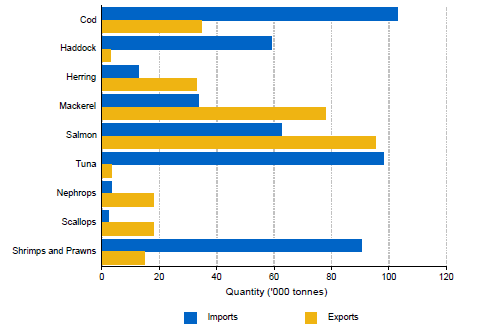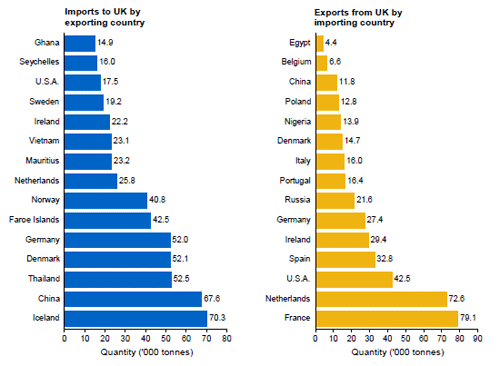Introduction
In 2011, the UK imported 720 thousand tonnes of fish (excluding fish products), with a value of
2,559 million. It exported 437 thousand tonnes, leaving a trade gap of 283 thousand tonnes.
Landed prices of fish rose by an average of 7.6 per cent on 2010, with the fish component of the
retail price index rising by 9.2 per cent. Fishing accounted for 7.1 per cent of gross value added for
agriculture, hunting, forestry and fishing.
This chapter brings together information on:
- Imports and exports of fish and fish products
- Household expenditure on fish and inflation of fish prices
- The contribution of fishing to GDP
The data on imports, exports, household consumption and GDP include information on fish from
freshwater fisheries and aquaculture, as well as from sea fisheries. This differs from the rest of the
publication, which focuses exclusively on sea fisheries. Note that in this chapter, landings data are
given in terms of landed weight for comparison with the trade data, which are shown in terms of
actual product weight.
All tables presented here are available to download as spreadsheets from the MMO website.
Supplementary tables showing more detail can also be found on the website.
Summary
The UK is a net importer of fish, with imports exceeding exports. The crude trade gap (imports minus exports) rose by 96 thousand tonnes to 283 thousand tonnes in 2011, an increase of 51 per cent on its 2010 level. This is due to both an increase in imports and a reduction in exports.
International Trade of Fish: 2001 to 2011

In addition to imports from abroad, supplies of fish to the UK include aquaculture, catches from
inland fisheries, and landings by UK vessels from sea fisheries. Data on aquaculture and catches
from freshwater fisheries are not included in this publication and hence total UK supplies of fish are
not estimated.
Landings by UK vessels into the UK (based on landed weight) fell by 6 thousand tonnes compared
with 2010 (see Table 4.1). Combining this with the 96 thousand tonnes increase in the crude trade
gap, and excluding aquaculture and catches from inland fisheries, the net effect is an increase in
the fish available for use in the UK of 90 thousand tonnes.
Tables 4.2 and 4.3 present information on exports and imports by species. Note that while imports
typically include landings into the UK by foreign-registered vessels, there may be cases where
imports are less than landings shown in Table 3.3; see Appendix 3 (UK fisheries statistics
methodology) for further details.
There were 720 thousand tonnes of fish (excluding fish products) imported into the UK in 2011.
This is up by 2 per cent on the 704 thousand tonnes imported in 2010. This rises to 827 thousand
tonnes if fish products are included. 2011 exports of fish stood at 437 thousand tonnes or 470
thousand tonnes if fish products are included. Exports in 2011 (excluding fish products) are down
by 15 per cent on the 517 thousand tonnes exported in 2010.
Imports and Exports by Species
Fish (excluding shellfish) accounted for 72 per cent of fish imports (including fish products) by
weight in 2011, a total of 597 thousand tonnes. Shellfish (molluscs and crustaceans) accounted for
15 per cent of imports by weight but 25 per cent by value. Fish products such as meals and flours
formed 13 per cent of the quantity of imports but only 4 per cent of the value.
The UK exported 340 thousand tonnes of fish (excluding shellfish) in 2011, and 97 thousand
tonnes of shellfish. Only 7 per cent of the quantity of UK exports of fish comprised fish products, a
total of 33 thousand tonnes, although this is 80 per cent higher than in 2010.
UK Imports and Exports by Key Species: 2011

In 2011, imports into the UK were highest for cod (103 thousand tonnes), tuna (98 thousand tonnes), shrimps and prawns (90 thousand tonnes), salmon (63 thousand tonnes) and haddock (59 thousand tonnes). Exports were highest for salmon (95 thousand tonnes) and mackerel (78 thousand tonnes).
Cod
The UK is a net importer of cod. Imports of cod in 2011 stood at 103 thousand tonnes (14 per cent
of fish imports), while exports were 35 thousand tonnes. Landings of cod by UK vessels into the
UK are relatively small and stood at 11 thousand tonnes in 2011. The amount available for
domestic use has decreased from 83 thousand tonnes in 2010 to 79 thousand tonnes in 2011.
Excluded from these figures is a small but growing amount of cod sourced from UK aquaculture.
Just over a quarter of all imports of cod in 2011 came from Iceland. The second largest exporter of
cod to the UK was China (16 thousand tonnes). Imports from EU member states accounted for 29
per cent of all cod imports into the UK in 2011.
Haddock
As with cod, the UK is heavily reliant on imports of haddock to meet consumer demand. Imports
account for 70 per cent of the total supply; very little is exported. Since 2007, the amount available
to consumers has fallen from 95 thousand tonnes to 81 thousand tonnes.
Half of all haddock imported into the UK in 2011 came from Norway (18 thousand tonnes) and
Iceland (12 thousand tonnes). The next largest was China, which exported 10 thousand tonnes of
haddock to the UK in 2011.
Shrimps and Prawns
UK vessels land only small amounts of shrimps and prawns into the UK: 0.4 thousand tonnes in
2011. The vast majority of shrimps and prawns available for domestic use are imported from
abroad. In 2011, 90 thousand tonnes of shrimps and prawns were imported into the UK. Some of
these are re-exported: 15 thousand tonnes of shrimps and prawns were exported in 2011, with a
total value of 81 million.
Over half the shrimps and prawns imported into the UK were from Asia. In 2011, the largest
exporters of shrimps and prawns to the UK were Thailand (20 thousand tonnes) and Iceland (11
thousand tonnes).
Tuna
Virtually all tuna available for use in the UK is from abroad. In 2011, the UK imported 98 thousand
tonnes of tuna, of which 3 thousand tonnes were re-exported, leaving 95 thousand tonnes
available for domestic use, a 9 per cent increase from 2010.
In 2011, 20 per cent of all tuna imported by the UK came from Thailand, and a further 19 per cent
came from Mauritius. Ghana exported a further 12 thousand tonnes to the UK, followed by the
Seychelles (11 thousand tonnes), the Philippines (10 thousand tonnes) and Ecuador (9 thousand
tonnes). Only 10 per cent of tuna was imported from EU member states.
Mackerel
The UK is a net exporter of mackerel. UK vessels landed 94 thousand tonnes of mackerel into the
UK in 2011. Combined with 33 thousand tonnes imported from abroad, this gave a total supply of
128 thousand tonnes. Only 50 thousand tonnes remained in the UK; the remaining 78 thousand
tonnes were exported.
A quarter of all UK mackerel exports in 2011 were to the Netherlands (20 thousand tonnes),
closely followed by Russia (18 thousand tonnes). Over two thirds of all mackerel exports were to
EU member states.
Salmon
In 2011, the UK exported 95 thousand tonnes of salmon. This freshwater species is sourced from
UK aquaculture and inland fisheries, as well as from imports. The UK imported 62 thousand tonnes
of salmon from abroad in 2011, making the UK a net exporter.
The USA was the largest importer of UK salmon, accounting for 39 per cent of salmon exports in
2011 (37 thousand tonnes). In 2011, 47 per cent of salmon exports went to EU member states, in
particular France, which imported 22 thousand tonnes of salmon.
Imports and Exports by Country
The largest exporters to the UK in 2011 were Iceland (70 thousand tonnes), China (68 thousand
tonnes), Thailand (53 thousand tonnes) and Denmark (52 thousand tonnes). Imports from Iceland
have fallen by a third since 2009 but have risen in China by almost a quarter.
The UK exported the largest amounts to France (79 thousand tonnes), the Netherlands (73
thousand tonnes) and the USA (43 thousand tonnes).
Imports and Exports by Country: 2011

Household Consumption and Inflation
Household consumption of fish fell in 2010, continuing a slow decrease since 2006. Consumer
expenditure on fish rose in 2010 to 3,790 million compared with 3,765 million in 2009. However,
household expenditure on fish fell slightly as a proportion of overall expenditure on food, to 5.2 per
cent in 2010, although figures for the three most recent years are by far the largest of the decade.
The landed price index (LPI) measures the average change in the prices of fish landed by UK
vessels into the UK at first sale. It provides a measure of domestic inflation in the price of fish
landed by UK vessels into the UK.
The consumer price index (CPI) measures the average change in the prices of goods and services
bought for the purpose of consumption in the UK. It includes a component for prices of fish, based
on a basket of six items: fresh white fish fillets, fresh salmon fillets, frozen prawns, canned tuna,
fish fingers, and frozen breaded/battered white fish. The retail price index (RPI) is a similar inflation
measure, calculated according to a different formula (see Appendix 3, UK fisheries statistics
methodology). The RPI uses the same basket of items for fish.
The fish components of the CPI and RPI both rose by 9.2 per cent, from 2010 to 2011. Prices of
first sale fish landed by UK vessels into the UK rose by an average of 7.6 per cent in 2011.
GDP for Fishing
The gross value added (GVA) for fishing has risen steadily in recent years, despite the global economic downturn. GVA for fishing now stands at 649 million, an increase of 61 per cent on 2001 levels. The growth in GVA for fishing comes against a background of considerable fluctuation in GVA in the wider agriculture, forestry and fishing sector over the past decade, with fishing now forming 7.1 per cent of GVA in this sector in 2011 compared with 4.9 per cent in 2001. UK gross domestic product increased steadily from 2001 to 2008, falling in 2009 during the height of the UK recession before increasing again to 1,309 billion in 2010 and 1,373 billion in 2011.
December 2012



